With June being LGBT Pride Month, we’re taking a looking at how LGBT content has been represented in mainstream American comics. This isn’t a complete history, but we hope you’ll find it informative of what’s happened so far and helpful in considering what the future should bring.
In Part 1 we covered the Golden Age of Comics, the creation of the Comics Code Authority, the first few stories that worked around the rules against LGBT content, and an editor who decreed that gays did not exist in the Marvel Universe (except for rapists in a “mature readers” magazine). Now we pick up in the 1980s.
UNDERGROUND COMIX, DIRECT MARKET, AND SUPPORTING CHARACTERS
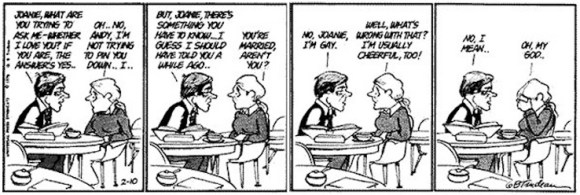
Of course, only mainstream publishers felt pressure from the Code. Independently published “underground comix” didn’t care about its restrictions on LGBT content and started positioning themselves as an alternative side of the medium. Likewise, newspaper strips were bound not by the Code but by the standards of each individual publisher. In 1976 Gary Trudeau‘s Pulitzer Prize-winning series Doonesbury featured character Joanie Caucus meeting Andy Lippincott. Joanie falls in love with him, but then it’s revealed that Andy is gay. Although heartbroken, Joanie comes to accept him as simply a friend. After a few months Andy vanished from the cast of Doonesbury. He then returned for a while in 1982, now acting a gay rights activist and speaking openly about LGBT political concerns.
In 1989 Andy reappeared in Doonesbury again, revealing that he had been diagnosed with AIDS. The next year followed his fight to enhance AIDS awareness followed by his final days and his funeral. A few newspapers wouldn’t run the storyline, saying it was in bad taste, but others praised it for educating many on AIDS issues. The story earned Doonesbury another Pulitzer Prize nomination. Despite being fictional, Andy Lippincott was given a panel on the AIDS quilt.
In the underground scene, Fantasy Quarterly started featuring the series ElfQuest in 1978. It would become a cult hit and often featured open ideas on sexuality and love. The series Gay Comix started in 1980 and was followed by more and more independent comics that delved into LGBT content and featured LGBT news. The same year that Andy returned to Doonesbury as a gay rights activist, DC Comics published the direct market mini-series Camelot 3000 as a “mature readers” story that didn’t carry the Comics Code Authority stamp. The story, written by Mike W. Barr and featuring art by Brian Bolland, featured people in the future realizing that they were reincarnations of the Knights of the Round Table. A woman named Amber regains the memories and personality of Sir Tristan and is repulsed by the fact that he now has a “weak” female form. This self-hatred increases when Tristan realizes a male friend is attracted to her and that his former lover Isolde has also been reincarnated, still as a woman. Isolde tries to get Tristan to accept that they can both be women and still be lovers.
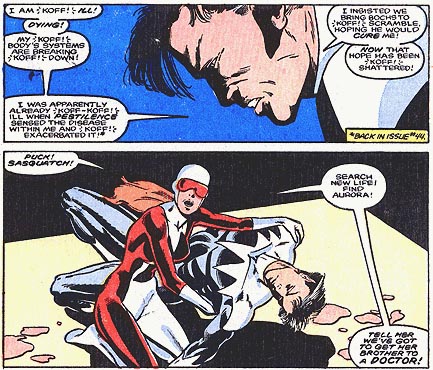
As the 1980s continued, Alpha Flight continued to imply that Northstar was gay, now more strongly under the direction of writer Bill Mantlo. In 1987 Northstar became mysteriously ill. It’s been reported that Northstar was going to be diagnosed as HIV-positive but that the Code wouldn’t allow it. In the meantime, Mantlo had Alpha Flight member Sasquatch die and then reincarnate in the body of his deceased female teammate Snowbird. Mantlo explored how people treated Walter (now “Wanda”) differently after the change. A couple of years later Sasquatch became male again and Snowbird was resurrected.
What about Jean-Paul’s illness, though? In Alpha Flight #50 Northstar learned from Loki, Asgardian god of lies and chaos, that his illness was due to the fact that he was secretly part elf and his magical biology was having trouble adjusting to Earth’s environment. Northstar was then magically cured and said goodbye to his team, leaving Earth’s dimension to go live with the elves he now considered to be his people.
This has gotta be one of the weirdest superhero plots I’ve read. Not even two years later it was thrown out the window. Northstar returned, revealing that he wasn’t part elf or part fairy or magical in any way. He was a human born with mutant powers, like the X-Men and others. All that stuff Loki told him was a lie because… well, Loki lies, so deal with it, okay?
While superheroes like Northstar weren’t allowed to be seen with a lover or say they were gay, supporting characters had a little more freedom. In 1982 Captain America #268, written by J.M. DeMatteis, introduced Arnie Roth, a childhood friend of Steve Rogers who protected him from bullies. As the two friends catch up for the first time in decades Arnie nervously explains that he never married because it never seemed “right,” but that he’s found happiness and stability in the company of Michael Blech, his “best friend” and roommate. Later in the same issue Steve sees Arnie and Michael share an emotional embrace, and it inspires him to finally open up to his romantic interest Bernadette “Bernie” Rosenthal. A few issues later, he tells Arnie that Michael is “one heck of a good guy.”
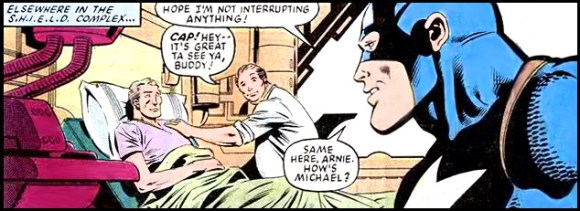
This was, frankly, pretty huge. The same year that the medical community finally adopted the acronym AIDS to replace terms like “gay cancer” or GRID (Gay-Related Immune Deficiency), Marvel’s WWII hero Captain America learned that someone he considered a brother was gay and accepted him with love. As a tragic contrast, the fact that Arnie was gay and Jewish made him a target for Captain America’s enemies who followed the Nazi ideology, such as the Red Skull and Baron Zemo.
The Code’s ban on LGBT content started loosening in the mid-1980s. As before, the guidelines for “mature readers” comics were even looser, with responsibility to keep them out of kids’ hands falling to individual comic book stores. One such story was the 1986 DC Comics series Watchmen by Dave Gibbons and Alan Moore, which briefly mentioned that the character Silhouette was a lesbian. But her life as a gay woman in the 1940s was not explored, as she only had two lines in the whole series. The same year saw the release of The Dark Knight Returns, wherein the Joker became a more effeminate character because writer Frank Miller considered him to be “a homophobic nightmare.”
In 1987 Superman #7 introduced readers to Maggie Sawyer, a tough Metropolis cop who intimidated enemies and colleagues alike. Less than a year later, Superman #15 revealed that Maggie lived with a “roommate” named Toby, a woman whom she was obviously close to and who called her “babe.” That same issue had Maggie reveal to Superman that she was divorced and had a daughter, Jamie.
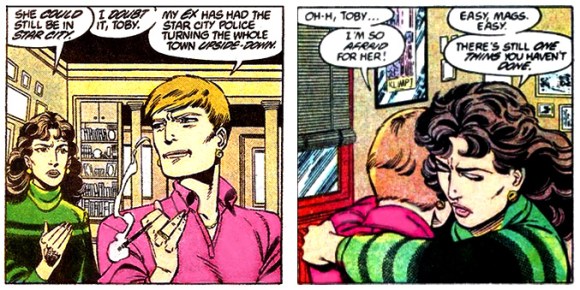
Maggie then shared her past, saying she had been “confused” for some time by troubling thoughts she tried to repress and deny, “things a proper Catholic girl didn’t even want to consider.” She accepted her boyfriend Jim’s marriage proposal largely because she thought it would stop those doubts and help her find what she was looking for. But years later, Maggie realized how unhappy she was and “finally came face to face… with reality.” This led to her divorce, at which point the judge deemed her unsuitable to have custody of Jamie.
The same year Maggie was introduced, a Swamp Thing and Hellblazer crossover involved the protagonists dealing with gay bashers. Both of these series were market to “mature readers” and eventually fell into DC’s less kid-friendly Vertigo imprint. Months later, in 1988, Wonder Woman Annual #1 introduced Kevin Mayer, brother of Wonder Woman’s friend and publicist Myndi Mayer. After coming out as a gay man, Kevin became active in HIV-awareness charities.
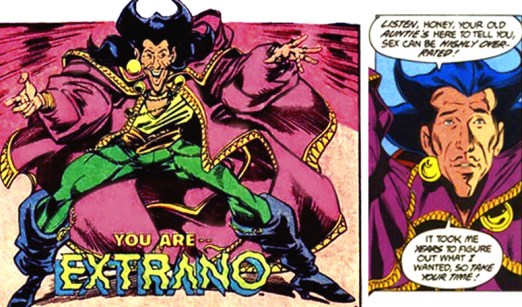
1988 also introduced the DC Comics hero Extraño, a cast member of the short-lived New Guardians series. He was technically the first openly gay superhero, because Northstar wasn’t open even though it was clear that his sister and a few other people knew. As an effeminate and flamboyant Peruvian sorcerer who referred to himself as “Auntie,” Extraño was criticized by many as a gay stereotype. He was later diagnosed as HIV-positive and later still met his death at the hands of the villain Krona.
GOODBYE RULES
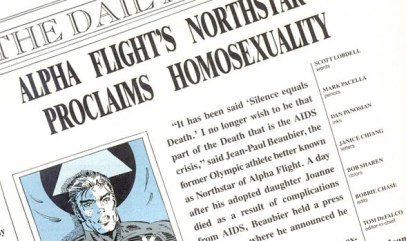
In 1989 the Code was altered yet again, and now there were no rules against LGBT content. The same year Doom Patrol author Grant Morrison re-imagined the heroes Negative Man and Negative Woman as a single, intersex character called Rebis. Neil Gaiman‘s Sandman series featured LGBT characters openly. In 1993 Rebis met Kate Godwin, a male-to-female transsexual who became the superhuman called Coagula.
With the Code gone, previously existing characters could now openly come out as LGBT or could be revised to be LGBT even if they weren’t created with that intention. Maggie Sawyer came out and openly discussed her sexuality. The 1940s hero known as the Destroyer, who also became one of the Marvel heroes to be called Union Jack, was revealed to be a gay man.
In 1992 writer Scott Lobdell was working on Alpha Flight and was asked to pitch a few ideas for a filler issue. For years Northstar had been portrayed as an increasingly antagonistic and rebellious character. Some considered this consistent with both the arrogance he’d displayed almost since his introduction and with stories that showed a distrust of the government. But Lobdell figured that Jean-Paul’s behavior resulted from his not being open about his sexuality. So for the filler issue, one of Lobdell’s pitches was that Northstar be confronted about how his staying in the closet was selfish when he could use his celebrity status to bring awareness to LGBT and HIV issues. Convinced by the argument, Northstar would then publicly come out.
Marvel approved, and the story was published in Alpha Flight #106. Lobdell didn’t consider the issue groundbreaking, as it was well known by many that Jean-Paul was supposed to be gay, but the story gained national medial attention. The New York Times called it a “welcome indicator of social change.”
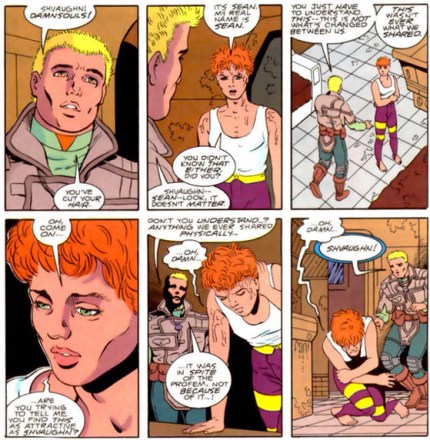
A few months later Legion of Super-Heroes #31 revisited Element Lad’s sexuality. Written by Mary and Tom Bierbaum, the story had Jan worry about his girlfriend Shvaughn’s increasing absences. Tracking her down, he discovers that Shvaughn Erin was born as a male named Sean Erin. For years Sean has been using a gender reassignment drug called ProFem. But with the economy now in dark times, she can’t afford as much of the drug and has been hiding whenever the effects wore off again. Element Lad, who knows a thing or two about changing physical matter, say that this doesn’t matter. He adds, “Anything we ever shared physically… it was in spite of the ProFem, not because of it!”
Two years later, though, the Legion of Super-Heroes continuity was rebooted from scratch. It has been rebooted three times since then. Since 1994 no mainstream version of Element Lad has been portrayed as or hinted at being homosexual or bisexual. But in Legionnaires #59 (1998), written by Roger Stern and Tom McGraw, LSH member Lyle Norg aka Invisible Kid was pleased to get a letter that read “Can’t wait to see you!” It was signed with the initial C. A few issues later, readers saw Lyle meet up with version of Condo Arlik. In the previous continuity, Condo had been the LSH member called Chemical King. 90s reboot Condo was a reporter. Some readers wondered if he and Lyle were in a relationship.
It was later revealed that this was indeed the intention, but the creative team altered the relationship before it could be outright stated. There was talk of eventually getting to it, but then the Legion of Super-Heroes continuity rebooted yet again in 2004 and the idea was dropped entirely. That same year saw the publication of The Definitive Guide to the Characters of the DC Universe. It is the only book published by DC Comics that actually states that Lyle and Condo were in a relationship.
Other stories openly dealing with sexuality followed. The Flash learned that his enemy-turned-ally Hartley Rathaway was gay, which made him feel awkward until he realized he was being a jerk. The Hulk learned that his old friend Jim Wilson was now HIV-positive. Justice League member Ice Maiden expressed sexual interest in both men and women but didn’t care for the label “bisexual,” arguing that people didn’t need to fit into boxes. Likewise, her teammate Todd Rice aka Obsidian admitted affection for his male best friend Al and argued that he didn’t want to define it. Kyle Rayner, the new Green Lantern, had a lesbian couple in his supporting cast named Li and Lee who were not treated as any more or less important than any other couple he knew.
1993 saw the creation of Milestone Comics, published through DC, which focused on minority representation and featured several LGBT characters. It shut down in 1997 and several of its characters, such as Static, were eventually absorbed into the DC Universe. Meanwhile, Peter David wrote a Supergirl series from 1993 to 2006 that featured a male and female character who co-existed in one body, each taking turns as the dominant form and persona. Both were attracted to Supergirl.
1998 saw the debut of Apollo and the Midnighter in the pages of Stormwatch. Created by Warren Ellis, the two heroes were clear homages to Superman and Batman, respectively, and had been working together for years. They and other Stormwatch characters spun off into a new series called The Authority. In 1999 Ellis’ final story on the series included a scene where the Midnighter affectionately kissed Apollo on the cheek before a dangerous mission, revealing them as a couple. Ellis had given readers a year to decide whether they liked the characters or not before revealing their sexuality. Years later, the two were married.
THE REMAINING INFLUENCE OF CENSORSHIP
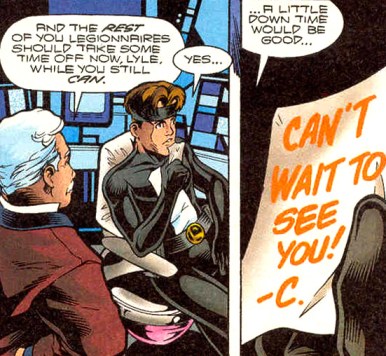
Despite all this, some argued that things still had a ways to go. For instance, while supporting characters were sometimes seen with partners, gay superheroes were not. The 1990s series Gen13 featured the hero Rainmaker openly talking about her attraction to women. Yet artists were told she could only kiss women on the cheek, not the lips. This led criticism from readers, who pointed out that the series didn’t balk from regularly featuring bloodshed, semi-nudity, and dismemberment. Similarly, some questioned a scene in the DC series Starman where bisexual alien superhero Mikaal Tomas kissed his boyfriend Tony. The scene was fully lit, but the kiss was depicted in shadow. And what about Lyle Norg? Why had it been necessary to hint at his relationship in a vague way instead of being open about it? Why couldn’t that letter be signed “Condo,” and then readers could see the two greet each other with a kiss? Meanwhile, in Marvel Comics, Northstar proudly discussed his sexuality in his autobiography Born Normal and occasionally got into fights with homophobes, but throughout the 1990s he was never seen in the company of a boyfriend. There was also the fact that nearly every transgender, transexual or intersex character owed this identity due to some magical or science fiction event. Some readers wondered if Mikaal Tomas coming from an alien society was a convenient excuse for his bisexuality.
Even without the Code’s restrictions on sexuality, some stories that intended to delve into LGBT content wound up altered. Raven Darkhölme aka Mystique was introduced as a shape-shifting terrorist in the first Ms. Marvel comic series in 1978. She was created by artist Dave Cockrum and writer Chris Claremont. After Ms. Marvel was cancelled, Mystique showed up with a full team of villains, the new Brotherhood of Evil Mutants, in Claremont and John Byrne‘s 1980 Uncanny X-Men story “Days of Future Past.” That same story teased a connection between Mystique and the hero Kurt Wagner aka Nightcrawler. Some readers guessed that Mystique was Kurt’s mother. Originally Claremont intended to reveal that Mystique and her teammate Irene Adler aka Destiny were lovers. Sometimes they coupled as two women, while other times Mystique would take the form of a man. Claremont intended that Nightcrawler would discover Mystique was actually his father and Destiny his mother.
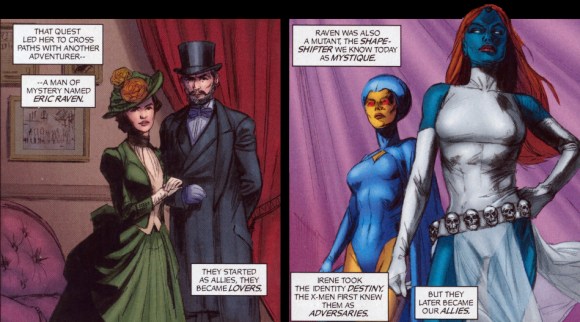
But this was during the 1980s, so the idea was flatly rejected. The Code would never allow it. During the 80s there were no hints about the two having a relationship beyond the fact that Destiny was the only person Mystique ever referred to as a friend and showed affection towards (not counting her adopted daughter Rogue). In Marvel Fanfare #40 (1988), Mystique took on the form of a man and danced with Destiny, calling her “my love” and affectionately saying how she cherished her. In 1989, the year the Code dropped its anti-LGBT rules, Uncanny X-Men #254 featured Destiny referring to Mystique as “my dearest friend – full of strength and courage and passion – that I have loved from the moment we met.” Destiny died soon afterward and Mystique’s grief was intense. In Uncanny X-Men #265 (1990), the villainous Shadow King refers to Destiny as Mytique’s “leman,” which is an old and largely forgotten word for “lover,” sometimes used to also imply that there’s something amoral about the relationship. Some readers missed this (and it’s possible editorial did as well).
Still, with the code’s anti-LGBT rules gone, Claremont could finally reveal that Raven was Nightcrawler’s father, right? Nope. Claremont left the X-Men in 1991, and the new creative team went down a different path. In X-Men Unlimited #4 (1994), Mystique told Nightcrawler that she was his mother, as had been suspected for years, and that his father had been a human named Christian Wagner.
It wasn’t until 2001, twelve years after the Code had taken away its LGBT content ban, that the comic mini-series X-Men Forever finally and explicitly referred to Destiny as Mystique’s “lover.” That same year, Marvel Comics dropped using the Comics Code Authority entirely, developing its own rating system instead. 2001 also saw the X-Force series reimagined by Mike Allred and Peter Milligan, then relaunched under the name X-Statix. The new team of mutant heroes featured three gay superheroes in its roster.
Following X-Men Forever, it was revealed that Destiny met Mystique when the shape-shifter had been living as a man named Eric Raven. Over the years they sometimes loved as two women, other times as a man and a woman. It’s sad that this relationship has only been briefly touched on in flashbacks, and even that only after Destiny’s death ensured that it wouldn’t affect present-day stories. Most of the Mystique stories that mention Destiny still don’t delve into the fact that they were lovers and companions for decades or address the emotional impact of Destiny’s death on Mystique. The hero Rogue never really talks about her experiences being raised by this same sex couple for years before joining the X-Men.

In recent years Destiny was resurrected, which happens a lot to X-Men characters in particular. But unlike many X-Men characters, she didn’t stay resurrected for long and died again before she could resume a relationship with Mystique. Maybe we’re just not allowed to see their romance fully explored.
Since we only had Mystique’s word that she was Nightcrawler’s mother, some readers aware of Claremont’s intention chose to believe that she had been lying and was in fact the hero’s father after all. That still could’ve happened. But in 2003 writer Chuck Austen confirmed in flashbacks that Mystique was Kurt’s mother and had indeed been married to Christian Wagner. Austen then revealed that Nightcrawler’s father was Azazel, a mutant with whom Mystique had an affair. Azazel evidently inspired certain demonic legends and looks just like Kurt except for being red instead of indigo.
I wish Mystique had been revealed as the father.
THE 21ST CENTURY
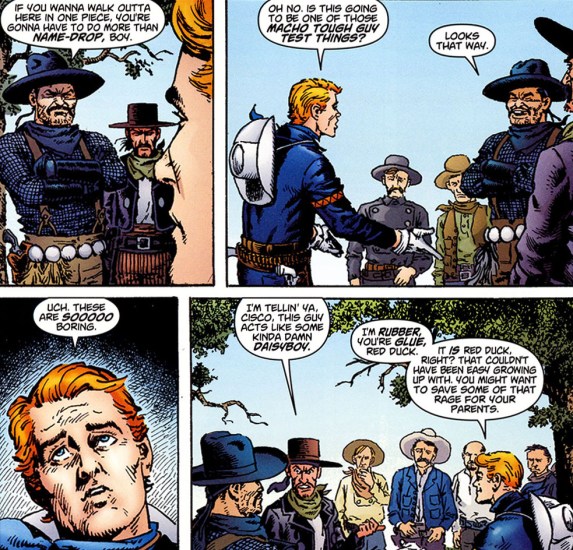
In 2003 several readers raised an eyebrow when the Marvel mini-series Rawhide Kid: Slap Leather displayed a label reading “Parental Advisory: Explicit Content” when there was no explicit content of a sexual or violent nature in the series at all. What warranted the warning was that the Rawhide Kid, a wild west hero originally created in 1955, was now interpreted to be gay. Rather than being stated outright in the story it was merely strongly implied through things like the Kid constantly making double entendres and other characters remarking on how clean and fancy he is. Some criticized that the mini-series missed an opportunity by relying on gay stereotypes for the sake of humor rather than seriously addressing the experience of being a homosexual in the wild west.
The same year that Slap Leather came out Marvel released the first Runaways series by Brian K. Vaughan, featuring the children of a group of super-villains. The first story arc included heavy implications that team member Karolina Dean, a girl who discovered both her parents were alien, was lesbian and had a crush on a teammate. That teammate didn’t reciprocate this crush, but in 2005 Karolina met new team member Xavin. More on that in a bit.
A homosexual mutant named Victor Borkowski aka Anole was introduced in New Mutants #2 in 2003. The original plan by writers Christina Weir and Nunzio DeFilippis was that Anole would come out to his family and immediately be shunned. Unable to deal with the situation, Anole would commit suicide. The story, planned for issues #8-10, was to be a powerful message about the damage caused by intolerance. But Marvel wasn’t too keen on the idea, so it changed. Rather than die to serve as a lesson, he remained in the X-books for years, gaining a fan base. He also formed a strong bond with Northstar. Oddly, the stories didn’t explicitly say he was gay until New Mutants #43 in 2012, even though many readers had figured it out and no one on the creative team kept it a secret.
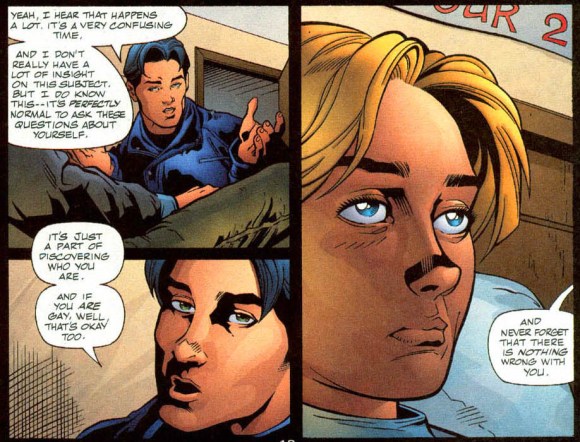
Back at DC Comics, the Green Lantern Kyle Rayner got a personal assistant in 2003, a teenage boy named Terry Berg. Terry acted like a big jerk towards Kyle’s girlfriend and the two finally had a talk about it in Green Lantern #137. Terry confessed he was jealous and Kyle asked if he was gay. Terry admitted, “I don’t know what I am.” Kyle told him that was all right and that what he was going through was normal. If he decided to identify as gay, that was fine.
Over the following issues, Terry realized he was homosexual and came out to his friends and family. Readers saw his mother deny the situation, deciding it was simply a phase that didn’t need to be discussed again. Terry’s father reacted almost violently. Nevertheless, Terry embraced who he was and developed a new confidence in life. Then he was attacked by gay bashers after they saw him kissing his boyfriend in public one night. Terry was hospitalized and comatose. Kyle initially responded by embarking on a quest for revenge but then stopped himself, not wishing to hurt others as brutally as Terry had been hurt. Despite critical injuries Terry made a full recovery, and his parents, realizing how close they had come to losing their son, finally accepted him. Terry was later seen with his own version of the GL power ring, but what that meant for his future was never revealed. Soon afterward DC decided to relaunch the Green Lantern series with Kyle’s predecessor Hal Jordan back in the lead role. Kyle left to star in spin-off titles while his supporting cast, Terry included, disappeared.
In another corner of the DC Universe, Maggie Sawyer transferred from Metropolis to Gotham City PD. From 2003 to 2006, Greg Rucka and Ed Brubaker wrote Gotham Central, a series that focused on the city’s cops, Maggie included. One of the major characters was Renee Montoya (originally named Rene). Renee had been created for Batman: The Animated Series but debuted in the comics months before her episodes aired in Batman #475 (1992). She became a familiar character to readers, rising to be one of the GCPD’s best detectives. In Gotham Central she was outed as a lesbian when a picture of her and a date kissing was posted to the station bulletin board. Renee had to deal with mockery from colleagues as well as anger and disapproval from her family.
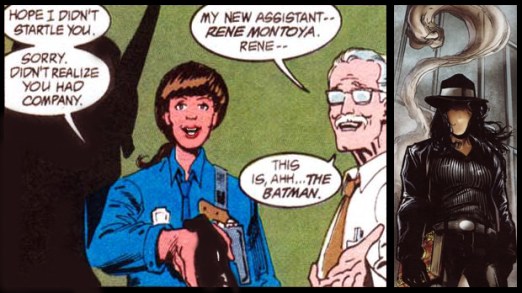
Following the book’s cancellation, Renee fell into a depression but then became ally to Vic Sage aka the Question in the pages of the weekly series 52. By the end of the series Renee had found a new purpose in life. Following Vic’s death Renee succeeded him as the new Question, becoming yet another out and proud superhero.
In 2004, writer Marc Andreyko introduced divorced mother and attorney turned superhero Kate Spencer in the series Manhunter. An openly gay man himself, Andreyko later included the character Todd Rice aka Obsidian in Kate’s supporting cast. For years, Obsidian had been interpreted as a hero who fell into villainy due to identity issues and going off medication. Touching back on the 1990s stories where he had feelings for his best friend Al, Andreyko revealed that Todd’s identity issues stemmed from denial of his own sexuality. By coming out of the closet in Manhunter, Obsidian gained stability and entered a committed relationship.
In 2005 DC published the 7 Soldiers saga by Grant Morrison, a large story divided between several mini-series. The Shining Knight mini-series introduced Sir Ystin, a reimagining of the Golden Age Shining Knight who’d been named Sir Justin of Camelot. Ystin inhabited a version of Camelot that existed in 8,000 B.C.E. The heroic boy turned out to have been born a female named Ystina. It was not clarified whether Ystina identified as male or had masqueraded as one in order to be accepted as a knight.
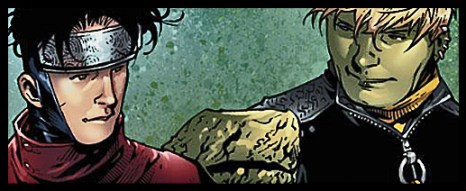
In 2005 Young Avengers debuted, introducing new teenage characters who modeled themselves after Marvel’s mightiest heroes. Creators Allan Heinberg and Jim Cheung originally intended that the characters Hulkling and Asgardian (the latter of whom later took the name Wiccan) were in love. Hulkling was going to be a female shapeshifter who then realized her true form was male, which would force Asgardian to decide whether this altered his feelings. Editor Tom Brevoort suggested that instead of delving into this complicated story, the two characters could simply be gay male teens in an open relationship.
Heinberg agreed, thinking he would drop “subtle” hints throughout several issues, but many readers figured it out during the first issue. The superhero couple became a hot topic of debate, with some criticizing teenage boys in love as a corruptive influence and others praising a book for having two out teenagers without putting a spotlight on their sexuality as their major defining trait. But even supporters noticed that it was many years before readers ever got to see Hulking and Wiccan actually kiss, despite being public about their relationship.
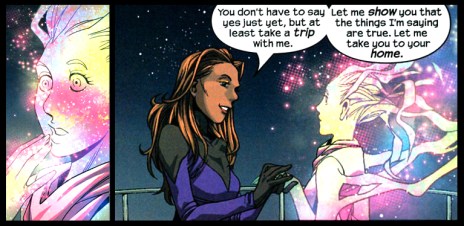
The idea of a shape-shifter deciding their dominant form was a different gender got used in Runaways in 2005. Xavin, a member of the alien Skrull race, intended to marry Karolina. Realizing she was a lesbian, Xavin became a female, figuring her form didn’t matter. Later on it was revealed that Xavin had truly accepted female as her gender, even reverting to it instinctively as her default form.
2006 was the fiftieth anniversary of Kathy Kane’s debut in DC Comics. In the weekly series 52, writer Greg Rucka reimagined the Batwoman as Kate Kane, an out lesbian who had once been romantically involved with Renee Montoya. Kate became popular very quickly, becoming the lead character of Batman’s title Detective Comics for a few months. It was revealed that while at West Point Kate had outed herself in order to protect someone else from investigation. As this was when “Don’t Ask, Don’t Tell” was still in effect, it meant she had to leave military service. Now Kate used her training to fight crime. During her story in Detective Comics Kate met Maggie Sawyer and the two began dating.
In 2007 Wolverine Origins #10 introduced Ahiro, the son of Wolverine. Calling himself Daken, this man had the same sex appeal and talent for violence that his father was known for, but none of his morality. Daken had pheromone based powers that let him control whomever he wished, seducing both men and women in different stories. Writer Marjorie Liu, who wrote the series Daken: Dark Wolverine, confirmed the character was bisexual. At a panel at Comic-Con International in 2009, she added “[Daken] will do anyone and anything [to achieve his goals and he’s] past that kind of identification. He’s beyond it.”
In 2008 Wonder Woman #18, written by Gail Simone, the heroic princess Diana presented her new love interest Tom Tresser aka Nemesis with a necklace and bracelet that she said were part of a traditional Amazon courtship ritual. Since all Amazons are women, Nemesis realized quickly that this ritual was normally done between women. Though it was implied Wonder Woman may have done this ritual with one of her Amazon “sisters,” it wasn’t confirmed. Makes sense though, right?
In 2009, 17 years after he came out, Northstar was finally given a boyfriend on-panel. That was also the year that ended a long-standing debate about the character Shatterstar’s sexuality. An alien warrior whose nature and origin was revised more than once, Shatterstar was created by Rob Liefeld and Fabian Nicieza and first appeared in the 1991 in the X-Men spin-off series New Mutants. When New Mutants relaunched as X-Force, Shatterstar came along for the ride and was one of the team’s most formidable members. Raised with to focus on combat, he seemed to have no real desire for a life outside of battle. In 1995 Nicieza explored the character’s emotional limitations by having Shatterstar confide to his teammate Rictor that he had never experienced romantic or sexual feelings. Nicieza later clarified, “I had planned to make Shatterstar think he was in love with Rictor, but only because he simply didn’t know any better about what love was.”
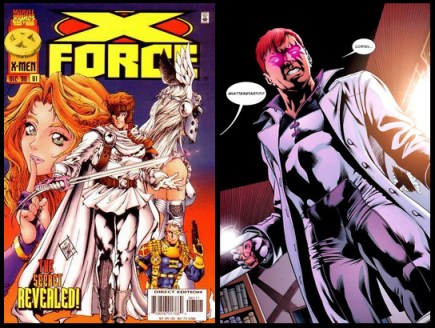
Nicieza left as writer soon afterward, and Jeph Loeb took over. Loeb made obvious hints that Shatterstar and Rictor were falling for each other and intended that they’d become a couple, but he left the series before he could write it in. As often happens when creative teams change, the sub-plot was simply dropped. In 2009, however, writer Peter David had Shatterstar and Rictor reunite in the pages of X-Factor and share a romantic kiss. David later explained that while Shatterstar had been raised to think only of combat, his experiences on Earth opened up his mind to romance. Shatterstar was revealed to be in love with Rictor and later stated that he was bisexual and polyamorous. Co-creator Liefeld immediately criticized this move, saying “Shatterstar is not gay. Sorry. Can’t wait to someday undo this.” He added: “Shatterstar is akin to Maximus in Gladiator. He’s a warrior, a Spartan, and not a gay one.”
In 2010 Archie Comics introduced its first openly gay character, Kevin Keller. His debut issue Veronica #202 sold out, becoming the first Archie Comics issue in history to get a second printing. Kevin got his own series two years later. That same year Life with Archie #16 revealed Kevin’s future as an adult. Readers learned that he will serve in the US Armed Forces, get injured, and then meet his future husband while recuperating in a military hospital. This became pretty big news, got lots of supporters, and seriously appalled groups like One Million Moms.
In 2011 DC Comics rebooted its superhero universe, replacing their main comics line with fifty-two new titles. Sadly, the “New 52” continuity ditched multiple LGBT characters who existed previously. Obsidian no longer existed, and there was an implication that Renee Montoya was dead (though DC later denied this and said there’s a possibility of her eventual return), The Question was once again a white male. Midnighter and Apollo still existed but were now strangers to each other. In the new Stormwatch series, writer Paul Cornell immediately showed Midnighter and Apollo becoming drawn to each other, saying in interviews that he was happy to show their courtship because that kind of relationship development between gay characters wasn’t often shown in mainstream comics.
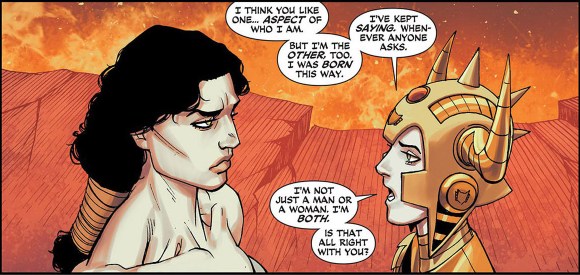
Cornell brought back Sir Ystin in the New 52 series Demon Knights, which took place during the dark ages. Ystin identified as male, but the character’s gender was an ongoing debate amidst some of the cast. In Demon Knights #13 Sir Ystin faces demons from Hell, one dressed as a male and the other as a female. Ystin is told, “You have to choose the bride or the groom. Either promises quite a wedding night. Too long have you refused to declare your sex. Reveal yourself before everyone! Now!” In Demon Knights #14 Sir Ystin discussed his gender and said, “I was born this way… I’m not just a man or a woman. I’m both.”
When asked if this meant that Ystin was intersex or transgender, Cornell said “I think that’s down to what each individual reader wants from that exchange, or most identifies with. Why shut down any of the possibilities?” Months later, writer Gail Simone revealed in Batgirl #19 that the hero’s roommate Alysia is a transgender bisexual. Simone said that she wanted to show a human character who was transgender in a grounded way rather than crediting it to magic or science fiction elements.
In 2012 DC announced that one of its major heroes would be reimagined as an openly gay man in the new continuity, later revealing that this was Alan Scott, the original Green Lantern. While some were happy about this development, others were critical of Alan’s boyfriend being immediately killed in the same issue that he first appeared in. There were also some who thought it would have been a braver choice to make the current Green Lantern an LGBT character rather than revising the 1940s incarnation, who wasn’t widely known to the public.
Around the same time, Marvel announced that Northstar would marry his boyfriend Kyle that summer. One Million Moms protested and called on supporters to write to the publishers and demand that Marvel back down for the sake of children. In spite of these protests, Northstar became the first openly gay superhero to marry a same sex partner in Astonishing X-Men #51, written by Marjorie Liu. Liu said that part of the reason for the marriage was to counter the idea in superhero comics that characters and couples cease to be interesting once they get married. This certainly contrasted the decision by Marvel in 2007 to erase Spider-Man’s 20 years of marriage from continuity, partly borne of a belief that matrimony limited his character.
Not long afterward DC Comics became the subject of a lot of fan rage. First the publisher hired Orson Scott Card to write a Superman story. A famous science fiction writer, Card has also actively tried to overturn same sex marriage legislation and called for violent action against government officials who made same sex marriage legal in the first place. Despite fan outrage and debate, the story was only cancelled when artist Chris Sprouse decided to drop out for his own reasons.

Another source of fan rage concerned Batwoman. Kate Kane proposed to Maggie Sawyer in 2013, but soon afterward DC readers learned that the book’s creative team of J. H. Williams III and W. Haden Blackman would be leaving. On his blog, Williams explained:
“From the moment DC asked us to write Batwoman — a dream project for both of us — we were committed to the unofficial tagline ‘No Status Quo.’ We felt that the series and characters should always be moving forward, to keep changing and evolving… Unfortunately, in recent months, DC has asked us to alter or completely discard many long-standing storylines in ways that we feel compromise the character and the series. We were… most crushingly, prohibited from ever showing Kate and Maggie actually getting married. All of these editorial decisions came at the last minute, and always after a year or more of planning and plotting on our end.”
Williams clarified that, as he understood it, DC did not prohibit the marriage because of homophobia but in order to stay with the New 52’s decision that superheroes not be married. The reboot also undid the marriages of Superman and Lois Lane, Green Arrow and Black Canary, and Barry Allen and Iris Allen. DC co-publisher Dan Didio explained that he believed, in general, that superheroes should not be married or have happy romantic endings because their lives require a level of tragic sacrifice. Many criticized it as a bizarre decision that unfairly limited the stories of DC’s characters and eliminated the drama inherent in seeing them enter any kind of relationship. What’s more, it limited the growth potential of the only lesbian superhero who led her own series from a mainstream publisher.

In terms of progress, there’s still a long way to go. With superhero movies and live-action shows going strong, many are hoping that LGBT characters and superheroes can appear on-screen. Renee Montoya is set to be a series regular on the upcoming TV show Gotham. Lesbian character Victoria Hand, played by bisexual actor Saffon Burrows, appeared in multiple episodes of ABC’s Agents of S.H.I.E.L.D. But her sexuality was never explored and then [TV spoiler] she was murdered while en route to a place called the Fridge, causing some to wonder if this was a dark joke on the phrase “women in refrigerators.” As for the comics themselves, many are critical of the fact that several LGBT characters still haven’t returned to the DC Universe, arguing that there’s no reason not to introduce new ones or reimagine familiar ones.
Of course, there are folks who complain, as Rob Liefeld did, that you shouldn’t reimagine characters to be LGBT if they were not originally created to be so. But as Gail Simone pointed out in an interview with Wired, “[A]lmost all the tentpoles we build our industry upon were created over a half century ago… at a time where the characters were almost without exception white, cis-gendered, straight, on and on. It’s fine — it’s great that people love those characters. But if we only build around them, then we look like an episode of The Andy Griffith Show for all eternity.”
How LGBT content will evolve in the future remains to be seen. It’s definitely a discussion that needs to keep happening.
Alan Sizzler Kistler (@SizzlerKistler) is an actor and author who identifies as a feminist and just loves comics. He sometimes work as a comic book historian and a geek consultant, and is the author of Doctor Who: A History.
Are you following The Mary Sue on Twitter, Facebook, Tumblr, Pinterest, & Google +?



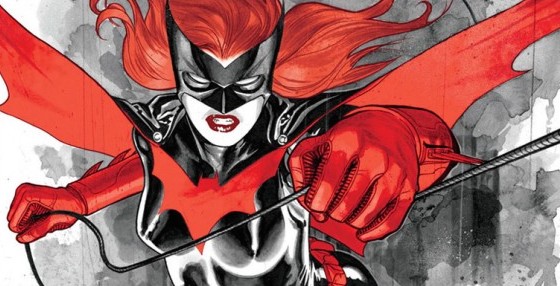





Published: May 16, 2014 12:32 pm